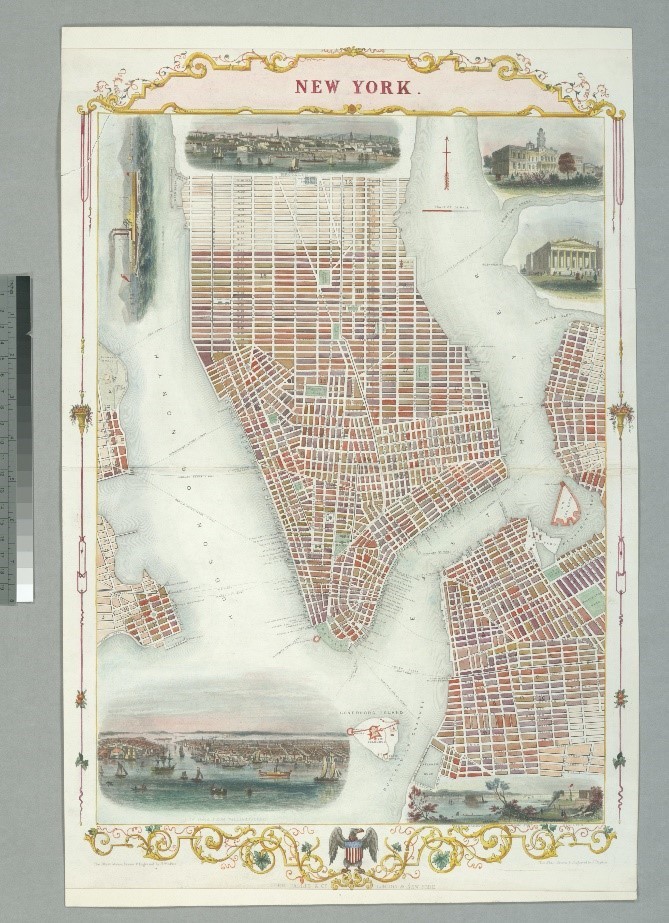Recently, this StreetCred blog post “All the Maps are Wrong” intrigued me: it pointed out that many maps are now out of date because many businesses have closed, permanently or temporarily, due to the COVID-19 pandemic. The maps inaccurately list businesses that may not have survived or have modified their service based on recent events and the impacts of shelter-in-place orders.

Historical map of New York City. New York Public Library, Digital Collections
This theory can be applied at a much larger scale, when we consider all changes on a global scale, whether they are caused by the pandemic or other more benign factors. The Earth is in a constant state of change; the environment is changing, infrastructure is changing, businesses are changing, patterns of life are changing.
With that context, our maps are all outdated, all the time–even before the pandemic. Often the problem is that the person looking at the map does not know the “age” of the map. Indeed, all maps are “historical maps” as they represent a snapshot of the Earth from a previous time. Even the trendiest, coolest map app you have on your smart phone right now is a “historical map.”
To solve this problem, mapmakers are constantly updating and refreshing maps, utilizing many sources of data and information. Organizations that depend on maps have invested heavily in data, data science, curators and cartographers who are in a perpetual game of collecting new information about our planet, refreshing their maps to make them “less wrong” or “less historical.”
The proliferation of sensors, cloud processing and artificial intelligence (AI) has revolutionized map making in recent years. We have sensors collecting a massive amount of data–in our devices, in our cities, on vehicles, up in the sky above us and in outer space–which are constantly observing the Earth (and other planetary bodies, but that’s a different post).
Maxar’s Earth observation satellites are among this giant fleet of space-based sensors, and they collect high-resolution information and data at an unmatched scale. Maxar satellites are accurate and have the ability to collect information quickly and in a timely fashion. Due to the infrastructure, communication systems and cloud computing, Maxar is able to acquire an image in space and analyze it on Earth within minutes. This type of data and speed of access is incredibly valuable for updating maps. Another way of saying it: we are shortening the time it takes to keep maps fresh. Soon, we will have maps that are minutes old, instead of months or years.
If you check out Maxar’s social media feeds, you’ll see countless examples of timely and current images from around the world highlighting news stories and events, such as this awesome image of the Blue Angel flyover honoring healthcare workers:

Maxar's Twitter post of the U.S. Navy Blue Angels flyover honoring healthcare workers.
While these are examples of timely images, to a map maker or data scientist, these are datasets of valuable and current information. Features and objects can be extracted from these datasets and used as an accurate source to update maps.
It wasn’t too long ago that this type of data was scarce. Datasets and maps are becoming abundant with the innovations of imaging technology, access to space and developments in machine learning and AI. Soon, we will be able to generate enough datasets to enable a map that is very close to being perfectly updated. Next year, Maxar will begin launching its new WorldView Legion satellites, which will bring an unprecedented advancement in Earth observation. Never before will the mapmakers of the world have access to this amount of current, accurate and high-resolution data about our changing planet. These datasets and maps will empower climate change scientists, enable smart cities and autonomous driving, allow rapid responses to global crises and ensure the safety and security of nations For a Better World.
Learn more about why currency matters.
Historical map source: https://digitalcollections.nypl.org/items/510d47df-e94d-a3d9-e040-e00a18064a99